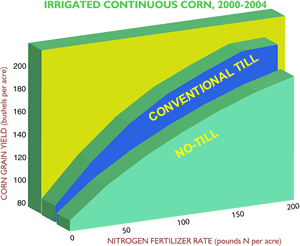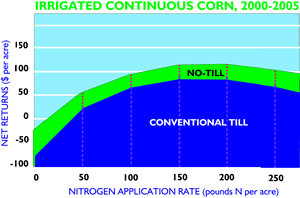This page has been archived and is being provided for reference purposes only. The page is no longer being updated, and therefore, links on the page may be invalid.
|
|
Higher yields from conventional till (above) could mistakenly convince growers to avoid no-till, which is actually more profitable (below). |
|
|
Proper Management Can Make Lower Yields Profitable
By Laura McGinnisJuly 9, 2007
In agriculture, less is sometimes more. That's the conclusion of Agricultural Research Service (ARS) scientists who discovered that reduced tillage can increase soil carbon, and that lower corn yields can net higher profits—under the right management.
Corn leaves a lot of crop residue, so many growers till fields intensively when preparing soil for the next crop. To find out how tillage affects greenhouse gas emissions, soil scientist Ardell Halvorson with the ARS Soil Plant Nutrient Research Unit, Fort Collins, Colo., and Arvin Mosier, formerly with ARS, measured trace gases being emitted from the soil in three cropping systems: corn under conventional till and continuous no-till, and a no-till corn-soybean rotation.
With several ARS colleagues, they found that when adequately fertilized, no-till soils sequestered more carbon than conventionally tilled soils, significantly reducing greenhouse gas emissions.
Halvorson and his colleagues also measured the effects of nitrogen fertilization and tillage—both conventional and no-till—on irrigated continuous corn yields. No-till management had multiple benefits, such as reducing soil erosion and fossil fuel consumption, sequestering carbon in the soil and lowering emission of greenhouse gases.
However, no-till also lowered yields by about 23 bushels per acre at optimal nitrogen rate.
The initial results made conventional tillage look like the better economic strategy, but further analysis revealed a surprising twist. David Archer, an ARS economist then located at the North Central Soil Conservation Research Laboratory, Morris, Minn., found that no-till was actually moreprofitable than conventional tillage. Archer is currently located at the Northern Great Plains Research Laboratory, Mandan, N.D.
Using a statistical model, Archer determined that no-till management increased net profits by enabling significant reductions in tillage operations, machinery and labor costs and fossil fuel consumption. Net savings were $83 per acre—enough to compensate for lower yields and still turn a profit.
The economic benefits for farmers using these conservation practices could be even greater when participating in USDA conservation programs.
Read more about the research in the July 2007 issue of Agricultural Research magazine.
ARS is the U.S. Department of Agriculture's chief scientific research agency.


